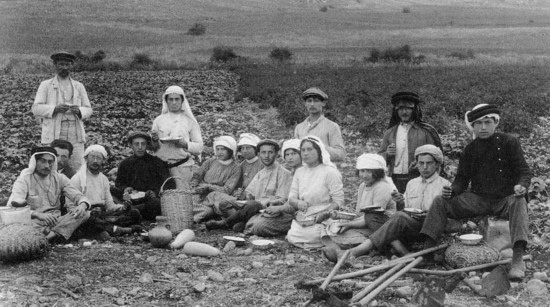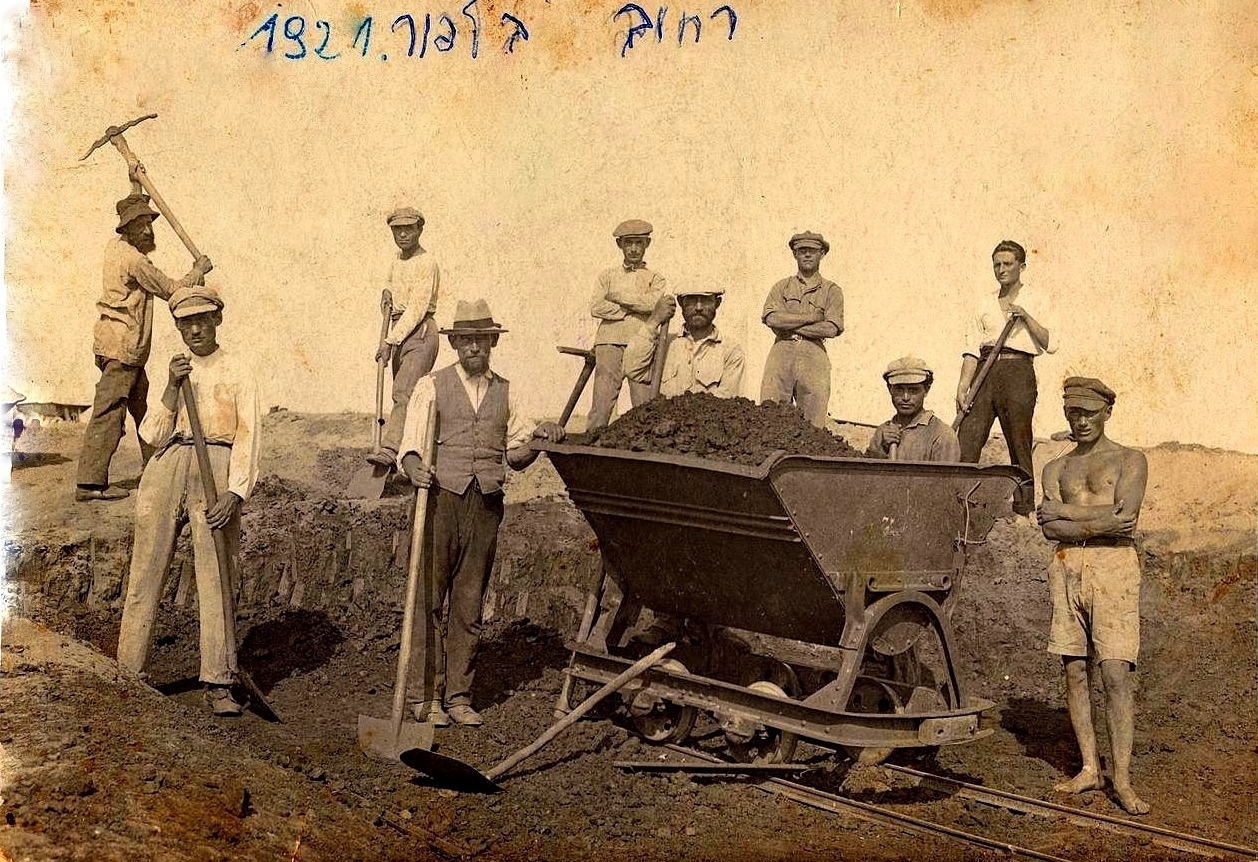IMMIGRATION & DEVELOPMENT
The movement of Jews from Europe to Palestine is essential to the success of the Zionist project. Immigration is the cornerstone of Jewish nationalism, for without it the Jews are left in Europe and there is no one in Palestine to develop the Jewish homeland. That’s why immigration is THE key source of tension and conflict between Jews, Arabs, and later the British, throughout the Zionist era.
aliyah
Aliyah means “to rise” or “go up” and refers to immigration to Israel. Beginning in the 1880s there have been successive waves of aliyot (the plural of aliyah), each with a distinctive name. Today aliyah has come to symbolize the idea that immigrating to Eretz Yisrael (the Land of Israel) is an act of raising up one’s soul, of fulfilling a spiritual need. The second season of Jew Oughta Know concerns the first five waves of aliyah, as follows:
Photo source: Wikipedia
First Aliyah, 1882-1903
The First Aliyah period ran from 1882 to around 1903, and somewhere around 25,000-35,000 Jews arrived, mostly from Eastern Europe. By the end of that period only about half or less ended up staying, because life was really hard. They were largely unable to build a functioning agricultural economy. They farmed individual plots of land, and sometimes tried grouping them together in small communities called moshavot. But these private farms weren’t viable, they weren’t really able to turn a profit to sustain an economy, and They had to be supported by Jewish philanthropic funds from abroad, most famously from Baron Edmond de Rothschild.
Photo source: Wikipedia
Second Aliyah, 1904-1914 (this is the main one you oughta know!)
The Second Aliyah proved to be a more consequential wave of immigration than the First, running from the beginning of the 1900s up to World War One in 1914. The Second Aliyah brought some 40,000 Jews into Palestine. As with the First Aliyah, most would end up leaving, some after just a few weeks. But those who stayed became the leaders of the Yishuv, building the institutions that would transform the land and turn the Jewish national homeland into the State of Israel.
The Second Aliyah brought in high-minded bourgeois European Jews looking to recreate the urban European landscapes that they took for high culture and elite intellectualism. So they began building cities like Tel Aviv. But mostly the Second Aliyah brought in immigrants to work the land. They took socialism and merged it with hard labor, and they created Israel’s perhaps most famous institution: the kibbutz.
The kibbutz
An unknown kibbutz. Photo source: Jewish Policy Center
“Ki-betz” is a Hebrew root word meaning “to gather or collect as a group”. The kibbutz was a collective farming community representing the practical expression of the revolutionary socialist ideology that Eastern European Jewish immigrants were bringing into Palestine in the early 1900s. There was searing heat, backbreaking work, little infrastructure or machinery to help with the labor, swamps and disease, and a rigid ideological structure. To be on a kibbutz wasn’t just to sign up for a life of labor, it was to sign up for an entire way of life.
Labor Zionism joined the ideals of socialism with an emphasis on physical labor, most often agriculture, as the way to develop a new kind of Jew: strong, industrious, deeply connected to the land. The kibbutz became the manifestation of this ideology and profoundly influenced pre-state and Israeli life, playing a hugely significant role in statebuilding and immigrant absorption. Members lived communally, often turning over their income to the kibbutz and sending their children to live in the kibbutz’s “Children’s House” from an early age.
The first kibbutz was named Degania, meaning “Cornflower”, and was established on the shore of the Sea of Galilee in 1909 by ten men and two women. The kibbutz movement had its heyday in the 1940s and 50s, and then went through a period of economic and demographic decline. Today there are over 250 kibbutzim in Israel, partaking in a various industries, from agriculture to tourism to hi-tech.
But the Second Aliyah began building more than just collective farms. These Jews also began developing cities, including a brand-new, Hebrew-speaking city literally on the beach:
Tel Aviv!
In 1909 the Zionist leader Arthur Ruppin got a loan from the Jewish National Fund for a small group of people to create a Jewish suburb next to the ancient port of Jaffa. They called their society “Ahuzat Bayit”, meaning “homestead”. The Ahuzat Bayit wanted to create the kind of small city they had left behind in Europe, except this one would be Hebrew in nature, adopt modern urban aesthetics, and be a center for Zionist culture. They even had marketing brochures advertising that the future city would have roads and sidewalks and electricity, and each house would have running water and sewage piping. On April 11, 1909, sixty-six families gathered on the beach to draw seashells to determine who got what plot of land.
A year later the tiny town was given a name to reflect the sense of both the ancient layered past as well as the Jewish renewal it was intended to bring about. The name came from the Book of Ezekial in the Hebrew Bible, where it was written of the Jews living in Babylon, “Then I came to them of the captivity at Tel Aviv.” Tel Aviv was also the Hebrew title given to Herzl’s 1902 book Altneuland, Old New Land. A tel is an ancient mound which covers layers of archeological evidence of past settlements. And aviv, means spring. So Tel Aviv can be translated as “Spring Hill.”
Roughly the same spot in Tel Aviv from its founding in 1909 (top) to a photo from 2016. Photo sources: top — Jewish Virtual Library, bottom — me.
Photo source: Wikipedia
Third Aliyah, 1919-1923
The upheaval of World War One, the Balfour Declaration of 1917, and the bloody Russian Revolution drove tens of thousands of Jews to Palestine in the third historic wave of immigration. Where most of the immigrants from the First and Second Aliyah waves ended up leaving, thanks to the hardship of agricultural life, the Third Aliyah immigrants, mostly young, had been trained in their native countries. So they arrived in Palestine ready to build. The influx of the Third Aliyah had two major impacts: it angered the Arabs, since more Jews were coming into Palestine; and it tied the Yishuv’s demographic more strongly to the socialist left.
Photo source: Wikimedia
Fourth Aliyah, 1924-1928
Half of the 80,000 new Fourth Aliyah immigrants were disillusioned blue collar workers from Poland, who settled not on the kibbutzim or the farms but in the towns and cities like Tel Aviv. The Third Aliyah built Palestine’s agricultural economy, and the Fourth built its urban one. These were the workers joining Ben Gurion’s Histadrut labor union in huge numbers. Anti-Semitism in Europe drove them out, immigration quotas in the United States kept them from America — so Palestine is where these middle-class families went.
Palestine immigration certificate. Photo source: Wikimedia
Fifth Aliyah, 1929-1939
The Fifth Aliyah brought in over 250,000 Jews to Palestine during the 1930s, nearly doubling the population of the Yishuv. Mostly middle-class Jews, they tended to settle in the bigger cities like Tel Aviv and Haifa, and in doing so dramatically boosted the Palestinian economy. A significant portion, around 60,000, of these immigrants came from Germany as part of the Ha’avara (Transfer) Agreement with the Nazis, in which Jews were allowed to leave in exchange for their wealth remaining in Germany. The huge influx of Jews during the 1930s also increased tensions with the Arabs, and contributed to the Arab Revolt of 1936-39.
Wikipedia National Library of Israel Jewish Agency for Israel
As these Jewish immigrants from Europe arrived in Palestine, they needed an economy to come to and places to live. The Zionist Movement found wealthy Jewish patrons in Europe like Baron Edmond de Rothschild, who funded small villages with essential human and governmental services, like Rishon LeZion, Rosh Pinna, and Zichron Ya’akov. The Jewish National Fund, which began with a 10 pound donation, purchased land for settlement, starting with 50 acres in 1903.
The life of a chalutz (pioneer) was enormously difficult, fraught with peril (malaria, marauding Arab bandits, crop failure). The experience was captured by Rachel the Poetess. Her writing romanticizes the idealism of the pioneers who came to Palestine to build a new Jewish homeland, but doesn’t shy away from the enormous individual challenges, costs, and consequences of those efforts.
Rachel Bluwstein (the Poetess). Photo source: Jewish Women’s Archive
El Artzi (To My Land)
Tel Aviv, 1926
I have not sung to you, my land
Nor have I glorified your name
Through deeds of heroism,
With the spoils of war:
Only a tree -- have my hands planted
Along the quiet shores of the Jordan.
Only a path -- have my feet trodden
Over the surface of the fields.
Indeed, it is very meager
I know this, mother,
Indeed it is very meager
The offering of your daughter;
Only the sound of the shout of joy
On the day that the light shines,
Only crying in secret
For your suffering.
(Translation from the Women’s League for Conservative Judaism)
As immigration and development continued apace through the 1920s, 30s, and 40s, the Yishuv (the Jewish community in Palestine) built ever larger and more sophisticated institutions that together functioned as a quasi-government. Political parties began to take shape. The Hebrew University was established. The Histadrut trade union began, and then grew to nearly define the economy. The Jewish Agency was a kind of “executive branch” of the Zionist movement, headed by David Ben Gurion.










